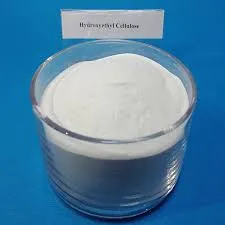
Nov . 06, 2024 13:51 Back to list
Solubility of Hydroxyethyl Cellulose in Ethanol and Its Implications for Applications
Solubility and Applications of Hydroxyethyl Cellulose in Ethanol
Hydroxyethyl cellulose (HEC) is a water-soluble polymer derived from cellulose, a natural polymer found in plant cell walls. It has gained significant attention in various industries due to its thickening, gelling, and film-forming properties. HEC is extensively used in pharmaceuticals, cosmetics, and food applications. One of the intriguing aspects of HEC is its solubility profile, particularly in ethanol, a common solvent used in many formulations.
HEC exhibits varying degrees of solubility depending on the solvent used. While it is predominantly known for its excellent solubility in water, the solubility of HEC in ethanol presents an interesting area of research and application. Ethanol, a polar solvent with a lower dielectric constant than water, interacts differently with polymers. The solubility of HEC in ethanol can be influenced by several factors, including the degree of substitution of the hydroxyethyl groups on the cellulose backbone, the molecular weight of the polymer, and the temperature of the solvent.
One key factor affecting the solubility of HEC in ethanol is the degree of substitution (DS). HEC is synthesized by etherifying cellulose with ethylene oxide, resulting in various grades of HEC with different DS values. Polymers with a higher DS generally exhibit better solubility in polar solvents. However, while HEC can dissolve in ethanol to some extent, its solubility is significantly lower than in water. This limited solubility indicates that HEC may not function effectively in ethanol-rich formulations without additional modifications.
Temperature also plays a crucial role in the solubility of HEC in ethanol. As the temperature increases, the kinetic energy of the molecules rises, which can enhance the interaction between the HEC polymer chains and the ethanol solvent. Consequently, HEC may become more soluble at elevated temperatures, making it easier to incorporate into various ethanol-based formulations. This feature is particularly advantageous in industries like pharmaceuticals, where temperature-controlled formulations are common.
hydroxyethyl cellulose solubility in ethanol

The applications of HEC in ethanol-based systems are notable, especially in the pharmaceutical and cosmetic sectors. In pharmaceuticals, HEC is used as a thickening agent, stabilizer, and controlled-release agent. Ethanol, often used in drug formulations, can modify the release profile of active ingredients. By incorporating HEC in ethanol-based gels or creams, formulators can create products that deliver drugs effectively over time. Moreover, HEC can enhance the texture and viscosity of topical formulations, improving the overall user experience.
In cosmetics, HEC is prized for its ability to provide a silky feel and emollience. Many cosmetic formulations utilize ethanol as a solvent for various active ingredients and fragrances. The inclusion of HEC can impart desirable rheological properties, ensuring that the products adhere well to the skin while maintaining a pleasant texture. Additionally, HEC's film-forming capabilities can help in creating water-resistant formulations, which are particularly valued in sunscreens and other outdoor products.
Despite its limited solubility in ethanol compared to water, HEC continues to be an integral component in developing effective and stable formulations. Research into modifying HEC to enhance its solubility in mixed solvents or optimizing its properties for specific applications is ongoing. Innovations in polymer chemistry could lead to new grades of HEC, potentially expanding its utility in ethanol-rich environments.
In conclusion, hydroxyethyl cellulose presents unique solubility characteristics when used in ethanol, making it a versatile ingredient in various formulations. Its ability to thicken, stabilize, and modify the release of active ingredients allows for the development of innovative products across multiple industries. Understanding the interplay between HEC's properties and its solubility in different solvents will continue to pave the way for more effective and desirable formulations in the future.
-
Versatile Hpmc Uses in Different Industries
NewsJun.19,2025
-
Redispersible Powder's Role in Enhancing Durability of Construction Products
NewsJun.19,2025
-
Hydroxyethyl Cellulose Applications Driving Green Industrial Processes
NewsJun.19,2025
-
Exploring Different Redispersible Polymer Powder
NewsJun.19,2025
-
Choosing the Right Mortar Bonding Agent
NewsJun.19,2025
-
Applications and Significance of China Hpmc in Modern Industries
NewsJun.19,2025







